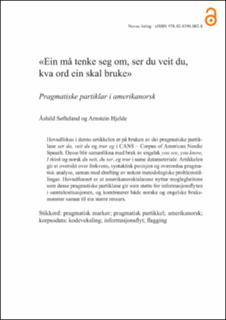| dc.contributor.author | Søfteland, Åshild | |
| dc.contributor.author | Hjelde, Arnstein | |
| dc.date.accessioned | 2022-02-03T07:54:05Z | |
| dc.date.available | 2022-02-03T07:54:05Z | |
| dc.date.created | 2022-01-11T19:28:53Z | |
| dc.date.issued | 2021 | |
| dc.identifier.citation | Hagen, K., Kristoffersen, G., Vangsnes Ø. A. & Åfarli T.A. (Red.). (2021). Språk i arkiva: Ny forsking om eldre talemål frå LIA-prosjektet. Novus. | en_US |
| dc.identifier.isbn | 9788283900811 | |
| dc.identifier.uri | https://hdl.handle.net/11250/2976765 | |
| dc.description.abstract | Hovudfokus i denne artikkelen er på bruken av dei pragmatiske partik-lane ser du, veit du og trur eg i CANS – Corpus of American NordicSpeech. Desse blir samanlikna med bruk av engelsk you see, you know,I think og norsk du veit, du ser, eg trur i same datamateriale. Artikkelengir ei oversikt over frekvens, syntaktisk posisjon og overordna pragma-tisk analyse, saman med drøfting av nokon metodologiske problemstil-lingar. Hovudfunnet er at amerikanorsktalarane nyttar moglegheitenesom desse pragmatiske partiklane gir som støtte for informasjonsflyteni samtalesituasjonen, og kombinerer både norske og engelske bruks-mønster saman til ein større ressurs. | en_US |
| dc.description.abstract | The main focus in this article is on the use of the pragmatic particlesser du, veit du og trur eg in CANS – Corpus of American NordicSpeech. These are compared with the use of English you see, youknow, I think and Norwegian du veit, du ser, eg trur in the same ma-terial. The article provides an overview of frequency, syntactic posi-tion and overall pragmatic analysis, together with a discussion ofsome methodological issues. The main finding is that the AmericanNorwegian speakers use the possibilities that these pragmatic partic-les provide as support for the information flow in the conversationalsituation, and combine both Norwegian and English usage patternstogether into a larger resource. | en_US |
| dc.language.iso | nno | en_US |
| dc.publisher | Novus Forlag | en_US |
| dc.relation.ispartof | Språk i arkiva. Ny forsking om eldre talemål frå LIA-prosjektet | |
| dc.rights | Navngivelse-DelPåSammeVilkår 4.0 Internasjonal | * |
| dc.rights.uri | http://creativecommons.org/licenses/by-sa/4.0/deed.no | * |
| dc.subject | pragmatisk markør | en_US |
| dc.subject | pragmatisk partikkel | en_US |
| dc.subject | amerikanorsk | en_US |
| dc.subject | kodeveksling | en_US |
| dc.subject | informasjonsflyt | en_US |
| dc.subject | flagging | en_US |
| dc.subject | korpusdata | en_US |
| dc.title | "Ein må tenke seg om, ser du veit du, kva ord ein skal bruke": Pragmatiske partiklar i amerikanorsk | en_US |
| dc.type | Chapter | en_US |
| dc.description.version | publishedVersion | en_US |
| dc.rights.holder | Copyright (c) 2021 Øystein A. Vangsnes, Kristin Hagen, Tor A. Åfarli; Ivar Berg, Leiv Inge Aa, Gjert Kristoffersen, Randi Neteland, Signe Laake, Lilja Øvrelid, Bente Selback, Terje Svardal, Karine Stjernholm, Ingunn Indrebø Ims, Eirik Tengesdal, Björn Lundquist, Øystein A. Vangsnes, Marit Westergaard, Lene Antonsen, Kristine Bentzen, Ragnhild Eik, Anu Laanemets, Ida Larsson, Kari Kinn, Brita Ramsevik Riksem, Terje Lohndal, Tor A. Åfarli, Åshild Søfteland, Arnstein Hjelde | en_US |
| dc.subject.nsi | VDP::Humaniora: 000::Språkvitenskapelige fag: 010::Nordiske språk: 018 | en_US |
| dc.source.pagenumber | 295-320 | en_US |
| dc.identifier.cristin | 1978819 | |
| dc.relation.project | Norges forskningsråd: 29 57 00 | en_US |
| dc.relation.project | Norges forskningsråd: 22 59 41 | en_US |
| dc.relation.project | Notur/NorStore: NS9691K | en_US |
| cristin.ispublished | true | |
| cristin.fulltext | original | |
| cristin.qualitycode | 1 | |

